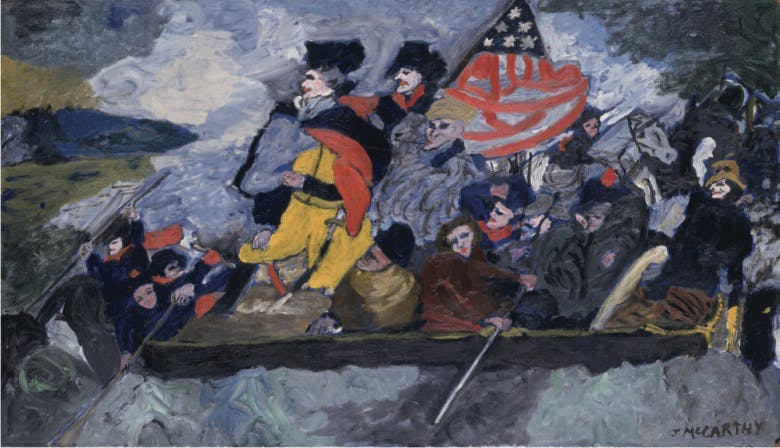Art Analysis: Washington Crossing the Delaware
Use this primary source imagery to analyze major events in history.
Suggested Sequencing
- Use this Primary Source with the Washington Crossing the Delaware Narrative.
Introduction
On a cold night in December 1776, the situation was desperate for General Washington’s army. His men were in disarray and being pursued by a professional army of one of the most powerful countries on earth. In desperation, Washington decided to cross the Delaware River and lead a surprise attack on a Hessian garrison camped in Trenton, New Jersey. Seventy-five years after this event, German artist Emanuel Leutze created his famous depiction of this scene. Leutze grew up in America but returned to Germany as an adult. He painted this work during the revolutions of 1848, a series of political upheavals throughout Europe. The painting is large at just over 12 feet high by 21 feet long. Leutze took several artistic liberties in his work. Most of Washington’s army crossed the river in shallow Durham boats—wide, flat boats with high sides. The high walls were sturdy enough to survive crossing an icy river. The men likely would have stood as they crossed, because the bottom of the boats would be wet, cold, and uncomfortable. Horses and artillery went across in larger ferries. The men crossed at around eleven o’clock at night in the middle of a strong storm that brought wind, freezing rain, and snow. Look carefully at the painting for several moments before answering the questions that follow.
Sourcing Questions
- (Figure 1) Who painted this work?
- (Figure 1) In what context was this painting created? What might this reveal about the author’s purpose in painting this scene?

Figure 1: Emanuel Leutze, Washington Crossing the Delaware, 1851.
Comprehension Questions
- (Figure 1) Describe the men in Washington’s boat. What does their attire reveal about the makeup of the Continental Army?
- (Figure 1) Describe Washington’s stance. Why do you think the artist portrayed him this way?
- (Figure 1) List at least three specific details in this painting that present historical inaccuracies.
Historical Reasoning Questions
Leutze’s most famous work has been copied many times in American art. Consider the two following pieces of modern art before answering the Historical Reasoning Questions.

Figure 2: Justin McCarthy, Washington Crossing the Delaware, Variation of a Theme #3, c. 1963. (credit: “Washington Crossing the Delaware, Variation on a Theme #3,” by Justin McCarthy/Smithsonian American Art Museum, Gift of Herbert Waide Hemphill, Jr.)

Figure 3: Roger Shimomura, Shimomura Crossing the Delaware, 2010. (credit: Shimomura Crossing the Delaware, Roger Shimomura, 2010, Acrylic on canvas, National Portrait Gallery, Smithsonian Institution; acquired through the generosity of Raymond L. Ocampo Jr., Sandra Oleksy Ocampo, and Robert P. Ocampo, © 2010, Roger Shimomura)
- (Figures 1-3) At the time, Washington’s decision to cross an icy river with his men was made in desperation, yet this moment in history is presented again and again in American art. What does this reveal about American history and memory?
- (Figures 1-3) Compare and contrast these depictions of Washington crossing the Delaware River with his men. If you had to create this scene, what would it look like?
Source Links:
- Emanuel Leutze, Washington Crossing the Delaware, 1851: https://commons.wikimedia.org/wiki/File:Washington_Crossing_the_Delaware_by_Emanuel_Leutze,_MMA-NYC,_1851.jpg
- Justin McCarthy, Washington Crossing the Delaware, Variation of a Theme #3, ca. 1963 https://americanart.si.edu/artwork/washington-crossing-delaware-variation-theme-3-16771
- Roger Shimomura, Shimomura Crossing the Delaware, 2010. https://npg.si.edu/sites/default/files/blog/6a00e550199efb883301b7c7c1ef60970b-pi.jpg

